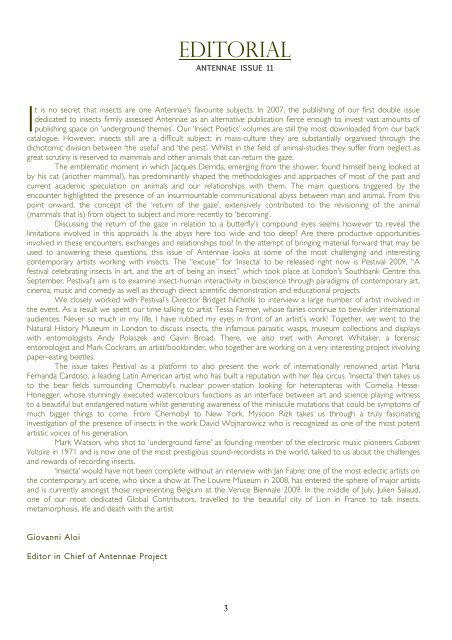Insecta - Antennae The Journal of Nature in Visual Culture
Insecta - Antennae The Journal of Nature in Visual Culture
Insecta - Antennae The Journal of Nature in Visual Culture
You also want an ePaper? Increase the reach of your titles
YUMPU automatically turns print PDFs into web optimized ePapers that Google loves.
It is no secret that <strong>in</strong>sects are one <strong>Antennae</strong>’s favourite subjects. In 2007, the publish<strong>in</strong>g <strong>of</strong> our first double issue<br />
dedicated to <strong>in</strong>sects firmly assessed <strong>Antennae</strong> as an alternative publication fierce enough to <strong>in</strong>vest vast amounts <strong>of</strong><br />
publish<strong>in</strong>g space on ‘underground themes’. Our ‘Insect Poetics’ volumes are still the most downloaded from our back<br />
catalogue. However, <strong>in</strong>sects still are a difficult subject: <strong>in</strong> mass-culture they are substantially organised through the<br />
dichotomic division between ‘the useful’ and ‘the pest’. Whilst <strong>in</strong> the field <strong>of</strong> animal-studies they suffer from neglect as<br />
great scrut<strong>in</strong>y is reserved to mammals and other animals that can return the gaze.<br />
<strong>The</strong> emblematic moment <strong>in</strong> which Jacques Derrida, emerg<strong>in</strong>g from the shower, found himself be<strong>in</strong>g looked at<br />
by his cat (another mammal), has predom<strong>in</strong>antly shaped the methodologies and approaches <strong>of</strong> most <strong>of</strong> the past and<br />
current academic speculation on animals and our relationships with them. <strong>The</strong> ma<strong>in</strong> questions triggered by the<br />
encounter highlighted the presence <strong>of</strong> an <strong>in</strong>surmountable communicational abyss between man and animal. From this<br />
po<strong>in</strong>t onward, the concept <strong>of</strong> the ‘return <strong>of</strong> the gaze’, extensively contributed to the revision<strong>in</strong>g <strong>of</strong> the animal<br />
(mammals that is) from object to subject and more recently to ‘becom<strong>in</strong>g’.<br />
Discuss<strong>in</strong>g the return <strong>of</strong> the gaze <strong>in</strong> relation to a butterfly’s compound eyes seems however to reveal the<br />
limitations <strong>in</strong>volved <strong>in</strong> this approach. Is the abyss here too wide and too deep? Are there productive opportunities<br />
<strong>in</strong>volved <strong>in</strong> these encounters, exchanges and relationships too? In the attempt <strong>of</strong> br<strong>in</strong>g<strong>in</strong>g material forward that may be<br />
used to answer<strong>in</strong>g these questions, this issue <strong>of</strong> <strong>Antennae</strong> looks at some <strong>of</strong> the most challeng<strong>in</strong>g and <strong>in</strong>terest<strong>in</strong>g<br />
contemporary artists work<strong>in</strong>g with <strong>in</strong>sects. <strong>The</strong> “excuse” for ‘<strong>Insecta</strong>’ to be released right now is Pestival 2009, “A<br />
festival celebrat<strong>in</strong>g <strong>in</strong>sects <strong>in</strong> art, and the art <strong>of</strong> be<strong>in</strong>g an <strong>in</strong>sect” which took place at London’s Southbank Centre this<br />
September. Pestival’s aim is to exam<strong>in</strong>e <strong>in</strong>sect-human <strong>in</strong>teractivity <strong>in</strong> bioscience through paradigms <strong>of</strong> contemporary art,<br />
c<strong>in</strong>ema, music and comedy as well as through direct scientific demonstration and educational projects.<br />
We closely worked with Pestival’s Director Bridget Nicholls to <strong>in</strong>terview a large number <strong>of</strong> artist <strong>in</strong>volved <strong>in</strong><br />
the event. As a result we spent our time talk<strong>in</strong>g to artist Tessa Farmer, whose fairies cont<strong>in</strong>ue to bewilder <strong>in</strong>ternational<br />
audiences. Never so much <strong>in</strong> my life, I have rubbed my eyes <strong>in</strong> front <strong>of</strong> an artist’s work! Together, we went to the<br />
Natural History Museum <strong>in</strong> London to discuss <strong>in</strong>sects, the <strong>in</strong>famous parasitic wasps, museum collections and displays<br />
with entomologists Andy Polaszek and Gav<strong>in</strong> Broad. <strong>The</strong>re, we also met with Amoret Whitaker, a forensic<br />
entomologist and Mark Cockram, an artist/bookb<strong>in</strong>der, who together are work<strong>in</strong>g on a very <strong>in</strong>terest<strong>in</strong>g project <strong>in</strong>volv<strong>in</strong>g<br />
paper-eat<strong>in</strong>g beetles.<br />
<strong>The</strong> issue takes Pestival as a platform to also present the work <strong>of</strong> <strong>in</strong>ternationally renowned artist Maria<br />
Fernanda Cardoso, a lead<strong>in</strong>g Lat<strong>in</strong> American artist who has built a reputation with her flea circus. ‘<strong>Insecta</strong>’ then takes us<br />
to the bear fields surround<strong>in</strong>g Chernobyl’s nuclear power-station look<strong>in</strong>g for heteropteras with Cornelia Hesse-<br />
Honegger, whose stunn<strong>in</strong>gly executed watercolours functions as an <strong>in</strong>terface between art and science play<strong>in</strong>g witness<br />
to a beautiful but endangered nature whilst generat<strong>in</strong>g awareness <strong>of</strong> the m<strong>in</strong>iscule mutations that could be symptoms <strong>of</strong><br />
much bigger th<strong>in</strong>gs to come. From Chernobyl to New York, Mysoon Rizk takes us through a truly fasc<strong>in</strong>at<strong>in</strong>g<br />
<strong>in</strong>vestigation <strong>of</strong> the presence <strong>of</strong> <strong>in</strong>sects <strong>in</strong> the work David Wojnarowicz who is recognized as one <strong>of</strong> the most potent<br />
artistic voices <strong>of</strong> his generation.<br />
Mark Watson, who shot to ‘underground fame’ as found<strong>in</strong>g member <strong>of</strong> the electronic music pioneers Cabaret<br />
Voltaire <strong>in</strong> 1971 and is now one <strong>of</strong> the most prestigious sound-recordists <strong>in</strong> the world, talked to us about the challenges<br />
and rewards <strong>of</strong> record<strong>in</strong>g <strong>in</strong>sects.<br />
‘<strong>Insecta</strong>’ would have not been complete without an <strong>in</strong>terview with Jan Fabre; one <strong>of</strong> the most eclectic artists on<br />
the contemporary art scene, who s<strong>in</strong>ce a show at <strong>The</strong> Louvre Museum <strong>in</strong> 2008, has entered the sphere <strong>of</strong> major artists<br />
and is currently amongst those represent<strong>in</strong>g Belgium at the Venice Biennale 2009. In the middle <strong>of</strong> July, Julien Salaud,<br />
one <strong>of</strong> our most dedicated Global Contributors, travelled to the beautiful city <strong>of</strong> Lion <strong>in</strong> France to talk <strong>in</strong>sects,<br />
metamorphosis, life and death with the artist.<br />
Giovanni Aloi<br />
Editor <strong>in</strong> Chief <strong>of</strong> <strong>Antennae</strong> Project<br />
EDITORIAL<br />
ANTENNAE ISSUE 11<br />
3












